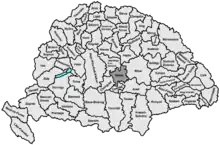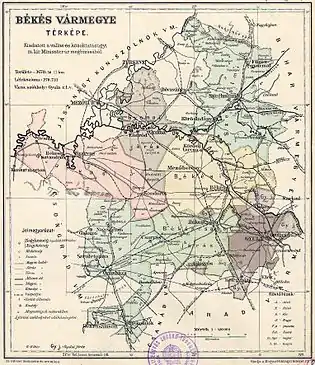Békés County (former)
Békés was an administrative county (comitatus) of the Kingdom of Hungary. Its territory, which was smaller than that of present Békés county, is now in southeastern Hungary. The capital of the county was Gyula.
| Békés County | |
|---|---|
| County of the Kingdom of Hungary (11th century-1541) County of the Eastern Hungarian Kingdom (1541-1566) County of the Kingdom of Hungary (1699-1786, 1790-1853, 1860-1946) | |
.svg.png.webp) Coat of arms
| |
 | |
| Capital | Békés; Gyula (1405-1946) |
| Area | |
| • Coordinates | 46°39′N 21°16′E |
• 1910 | 3,670 km2 (1,420 sq mi) |
| Population | |
• 1910 | 298710 |
| History | |
• Established | 11th century |
• Ottoman conquest | 1566 |
• County recreated | 1699 |
• Merged into Békés-Csanád-Csongrád County | 1 June 1786 |
• County recreated | 26 April 1790 |
• Merged into Békés-Csanád County | 10 January 1853 |
• County recreated | 20 October 1860 |
• Monarchy abolished | 1 February 1946 |
| Today part of | |
Geography
Békés county shared borders with the Hungarian counties Csongrád, Jász-Nagykun-Szolnok, Hajdú, Bihar, Arad and Csanád. The river Körös flowed through the county. Its area was 3671 km² around 1910.
History

Békés county arose as one of the first comitatus of the Kingdom of Hungary, in the 11th century. In 1950, the territory of Békés county was expanded with:
- the northeastern part of former Csanád-Arad-Torontál county (the Hungarian part of pre-1920 Arad county and the north-eastern part of pre-1920 Csanád county)
- a part of former Bihar county (the area around Sarkad and Okány)
- a part of Jász-Nagykun-Szolnok county (the area around Dévaványa)
Demographics
1900
In 1900, the county had a population of 278,731 people and was composed of the following linguistic communities:[1]
Total:
- Hungarian: 201,619 (72,4%)
- Slovak: 64,467 (23,1%)
- German: 6,191 (2,2%)
- Romanian: 6,069 (2,2%)
- Serbian: 31 (0,0%)
- Ruthenian: 23 (0,0%)
- Croatian: 21 (0,0%)
- Other or unknown: 310 (0,1%)
According to the census of 1900, the county was composed of the following religious communities:[2]
Total:
- Lutheran: 98,882 (35,5%)
- Calvinist: 95,548 (34,3%)
- Roman Catholic: 66,857 (24,0%)
- Greek Orthodox: 7,870 (2,8%)
- Jewish: 7,358 (2,6%)
- Greek Catholic: 773 (0,3%)
- Unitarian: 599 (0,2%)
- Other or unknown: 844 (0,3%)
1910

In 1910, the county had a population of 298,710 people and was composed of the following linguistic communities:[3]
Total:
- Hungarian: 219,261 (73,4%)
- Slovak: 66,770 (22,4%)
- Romanian: 6,125 (2,1%)
- German: 6,048 (2,0%)
- Ruthenian: 4 (0,0%)
- Croatian: 17 (0,0%)
- Serbian: 76 (0,0%)
- Other or unknown: 409 (0,1%)
According to the census of 1910, the county was composed of the following religious communities:[4]
Total:
- Lutheran: 105,724 (35,4%)
- Calvinist: 98,596 (33,0%)
- Roman Catholic: 75,738 (25,4%)
- Greek Orthodox: 8,374 (2,8%)
- Jewish: 7,444 (2,5%)
- Unitarian: 893 (0,3%)
- Greek Catholic: 748 (0,2%)
- Other or unknown: 1,193 (0,4%)
Subdivisions

In the early 20th century, the subdivisions of Békés county were:
| Districts (járás) | |
|---|---|
| District | Capital |
| Békés | Békés |
| Békéscsaba | Békéscsaba |
| Gyoma | Gyoma |
| Gyula | Gyula |
| Orosháza | Orosháza |
| Szarvas | Szarvas |
| Szeghalom | Szeghalom |
| Urban districts (rendezett tanácsú város) | |
| Gyula | |
_2.jpg.webp)
References
- "KlimoTheca :: Könyvtár". Kt.lib.pte.hu. Retrieved 2012-06-24.
- "KlimoTheca :: Könyvtár". Kt.lib.pte.hu. Retrieved 2012-06-24.
- "KlimoTheca :: Könyvtár". Kt.lib.pte.hu. Retrieved 2012-06-24.
- "KlimoTheca :: Könyvtár". Kt.lib.pte.hu. Retrieved 2012-06-24.
